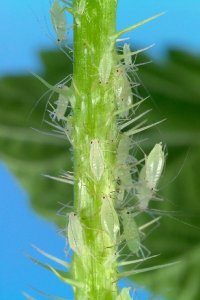
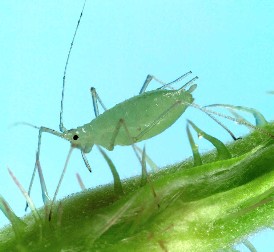
Raspberry can be colonised by several aphid species, but two are particularly important, the large raspberry aphid (Amphorophora idaei) and the small raspberry aphid (Aphis idaei). Apart from causing direct feeding damage and contamination to fruit and leaves, both are vectors of some of the most important raspberry viruses e.g. Raspberry leaf spot/mottle viruses.
Image to left is a large raspberry aphid colony on a raspberry cane
The large raspberry aphid is widespread on raspberry in northern and western Europe. This aphid is very closely related to the Blackberry aphid (Amphorophora rubi) that feeds on blackberry and this has resulted in confusion in the past. They can be differentiated by their host specificity or by the number of chromosomes each contain (reference: Blackman R L, Eastop V F, Hills M 1977. Morphological and cytological separation of Amphorophora Buckton (Homoptera: Aphididae) feeding on European raspberry and blackberry (Rubus spp.) Journal Bulletin of Entomological Research 67, 285-296.
Above is an alatae large raspberry aphid

Aphids over-winter as eggs on the lower portion of the primocanes. They emerge as females in spring and feed initially on the fruiting laterals. Populations build up slowly early in the year when feeding on fruiting cane. The aphids develop wings in June and July and migrate to other raspberry crops or to primocanes within the plantation. The largest numbers coincide with the period of fruit harvest. In early autumn, males develop and mate with the females who lay eggs at the bases of primocanes.
Image to right is of large rapsberry aphid eggs overwintering on primocanes
Managing the large raspberry aphid relies on use of resistant cultivars, insecticides and biological control, singly or in combination. Until recently, resistant cultivars were the method of choice. However, with the development of aphid biotypes able to feed on plants of the most commonly used resistance gene, gene A1 (see page on host resistance genes ) reliance is now focused on another resistance gene, gene A10. There is now increasing evidence that gene A10 containing raspberry plants are being colonised by another recently evolved large raspberry aphid biotype. Research is currently being undertaken to understand the process involved to make the resistance genes more durable. Some Institute bred Raspberry cultivars and contain aphid resistance genes, click here to see details.
The number of insecticides available for use in raspberries to control raspberry aphids is very limited. Further limitations occur when the crop is covered or fully protected. For advice, contact your local advisor or extension service.
At present there are no reliable biological control agents available but several can be used in conjunction with insecticides. Most are naturally occurring but some may be augmented by commercially available products. The most abundant natural predators and parasites in Scotland are listed below.
Small Raspberry Aphid

The small raspberry aphid is common in warmer parts of southern and central Europe, including southern England. The damage caused by this aphid is more pronounced than the large raspberry aphid with heavy infestations resulting in badly distorted canes, especially close to the growing tips. However, the damage caused has little consequence on yield. Occasionally, the larger colonies may be attended by ants feeding on the honeydew. They are vectors of the raspberry vein chlorosis virus (RVCV), and losses caused by this virus may be significant.
Above picture is of ants foraging for honeydew deposited by small raspberry aphid colony
At present there are no commercially available cultivars showing resistance to these aphids, although there are differences in susceptibility and damage expression.
Research is currently on-going to understand the potential risk on these aphids becoming more widespread in Scotland with the advent of protected crops.
Other Aphids
The potato aphid (Macrosiphum euphorbiae) is frequently found on the fruiting laterals of raspberry in the spring and early summer. Although numbers can be high, there is little evidence that they cause significant damage. There appears to be little risk of virus spread by these aphids but further studies are needed.
Peach-potato aphid (Myzus persicae) and the Cotton-melon aphid (Aphis gossypii) have been reported on protected and semi-protected raspberry. As yet, there is insufficient evidence to regard them as serious pests.
| Predators | Common Name | Scientific Name | |
|---|---|---|---|
| Ladybirds (Ladybeetles) | Seven- spotted Ladybird | Coccinella septempunctata | 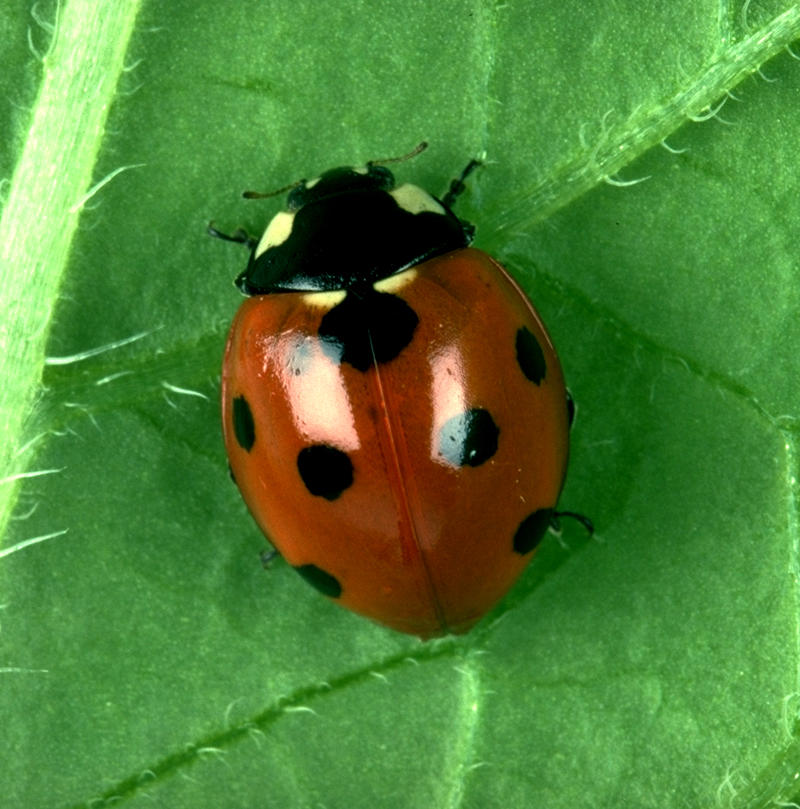 |
| Ladybirds (Ladybeetles) | Two-Spotted Ladybird | Adalia bipunctata |
|
| Predatory Midges | n/a | Aphidoletes aphidimyza | 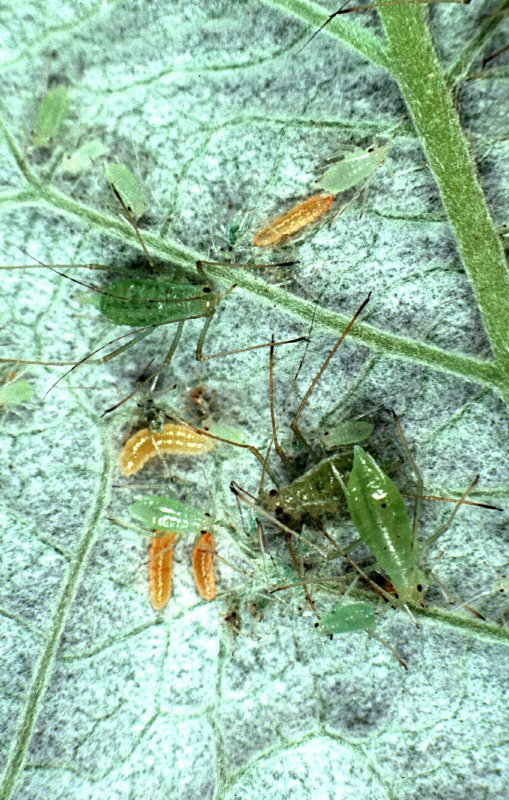 |
| Lacewings | Common green lacewing | Chrysoperla carnea | 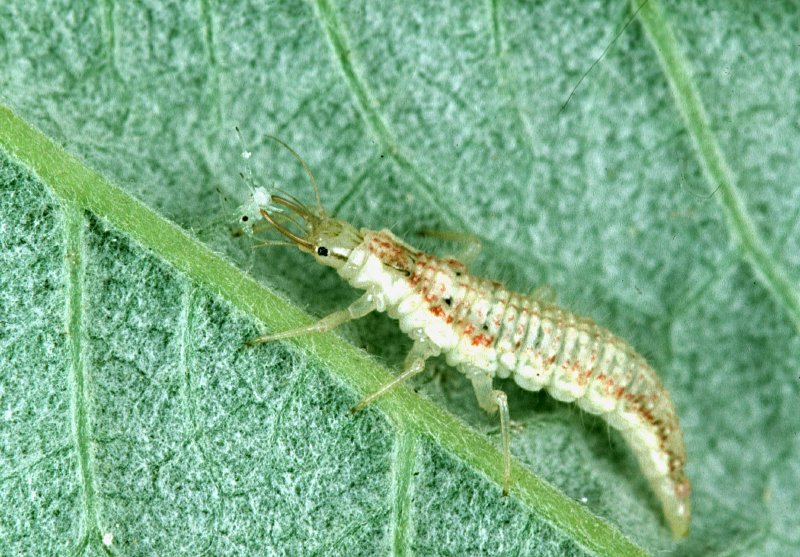 |
| Hoverflies | n/a | Syrphus spp. Episyrphus sp. and others | 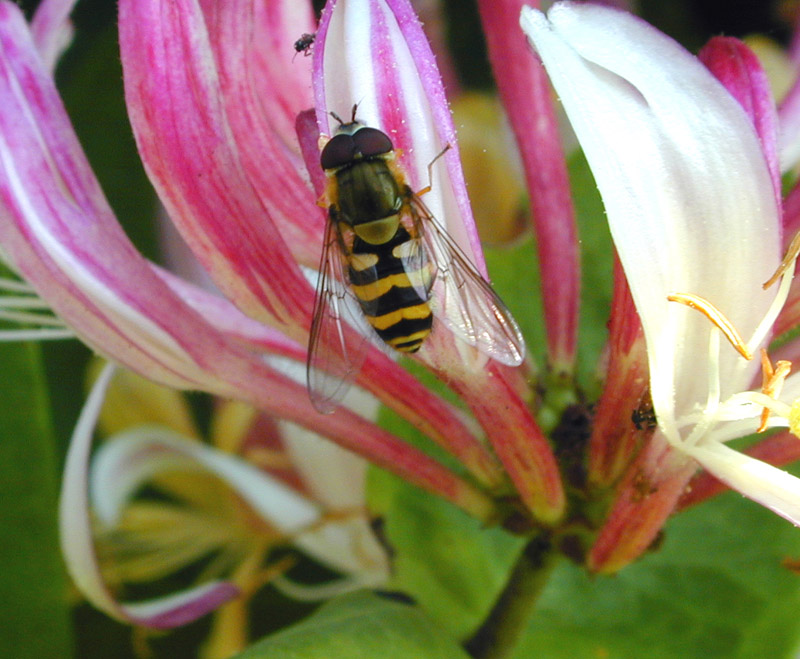 |
| Parasitoids | |||
| Aphidiidae | n/a | Praon sp. | |
| Braconidae | n/a | Aphidius spp. |  |
| Click on links for photographs |
References
- Birch ANE, Jones AT, Malloch G, Fenton B and Gordon SC (2003) Resistence-breaking raspberry aphid biotypes: a challenge for plant breeding. IOBC/wprs Bulletin. 26, 51-54.
- Birch ANE, Jones AT, Fenton B, Malloch G, Geoghegan I, Gordon SC, Hillier J and Begg G (2002) Resistance-breaking raspberry aphid biotypes: constraints to suitable control through plant breeding. Acta Horticulturae, 587, 315-317.
- Birch ANE, Jones AT, Fenton B, Malloch G, Geoghegan I, Gordon SC, Hillier J and Begg G (2004) Resistance-breaking raspberry aphid biotypes: Constraints to sustainable control through plant breeding and Integrated Crop Management. IOBC wprs Bulletin 27 (7), 1-3.
- Mitchell C (2007) Novel approaches to development of integrated pest management in UK raspberry production. PhD Thesis, University of Dundee, pp. 221.

